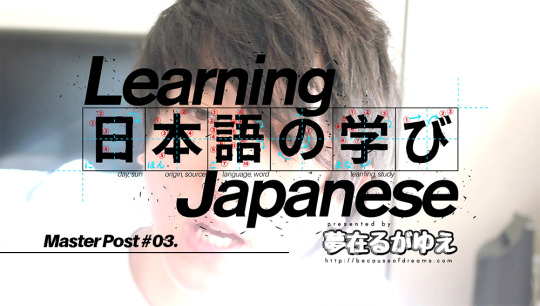Difficulties communicating with my Japanese boyfriend and my attempts to learn the Japanese language
Don't wanna be here? Send us removal request.
Text
みなと〜Japanese learning website

so, I found this great Japanese learning website today, and I couldn’t wait to tell you guys about it!! its a really great website for total beginners and pre-intermediate levels. it has great lessons, quizzes, videos, studying materials and references. if you’re learning Japanese I totally recommend this website :)
584 notes
·
View notes
Text
Japanese Mini Grammar (JLPT N4): Turn a sentence into a yes or no question with かい (kai)

Happy learning °˖✧◝(⁰▿⁰)◜✧˖°
…………………………………………
Useful Links:
• CrunchyNihongo - Easy to Learn Japanese Lessons Site • Get our easy Japan lessons on your facebook timeline • FREE DOWNLOAD! Resourceful app to start learning Japanese! • Books to guide & help you learn Japanese
402 notes
·
View notes
Photo

Learning Japanese Master Post #03.
Here’s a master post for video lessons #101-#150 in the Learning Japanese video series, all view-able for free on YouTube! That’s right, each topic gets its own episode! All arranged in order and linked below. Check out all 200+ video lessons at the official YouTube channel here and the other Master Posts: 1 2
youtube
Negative-Form VERB + なくて(はいけない/もいい) as “(X must VERB/it’s OK if X doesn’t VERB)”
How-to ask for and give advice with たら-Form Verb + (いいですか/どうですか)?
Passive Form (Verb Conjugation)
Passive Form (Simple)
Passive Form (Adversity with Transitive Verbs)
Passive Form (Adversity with Intransitive Verbs)
Causative Form (Verb Conjugation)
Causative Form
(Dictionary/Negative-ない Form)CLAUSE1とCLAUSE2 as “C1 and C2” (pt. 1 of 2)
(Dictionary/Negative-ない Form)CLAUSE1とCLAUSE2 as “C1 and C2” (pt. 2 of 2)
Japanese Word Beautifiers お and ご
なら Construction - CLAUSE1ならCLAUSE2 as “if CLAUSE1 is the case, CLAUSE2”
(UNIT OF TIME)にCLAUSE as “CLAUSE every/per X”
NOUN1はNOUN2(と/に)関係がある as “NOUN1 is related to NOUN2”
Dictionary-Form VERB必要がある as “need to, have to VERB”
X(では/じゃ)なく(て)Y as “not X but Y”
(CLAUSE/NOUN1)だけ(で/じゃ)なく(て)NOUN2も as “not only (CLAUSE/NOUN1) but NOUN2 too”
NOUNの代わりに as “in the place of NOUN, instead of NOUN, in lieu of NOUN”
Pre-ます-Form VERB 続ける as “continue to do VERB”
思うように+Negative-ない-Form VERB as “does not VERB as desired”
NOUN1でもNOUN2でも as “whether it’s N1 or N2/including N1 and N2”
Dictionary-Form-VERB + べき as “should do VERB”
Xを(している/した)NOUN as “NOUN that has the quality of X”
(CLAUSEこと/NOUN)に気がつく as “to realize ____”
(CLAUSE1/NOUNの) + (おかげ/せい) as “(thanks to/due to the fault of) ____”
決して + Negative-Form-(VERB/ADJ/NOUN) as “by no means (VERB/ADJ/NOUN)”
NOUN と(同じで/違って) CLAUSE as “(just like/unlike) NOUN, CLAUSE”
NOUN + なし + (の/で/だ) as “without NOUN”
NOUN + 次第 (だ/で) as “depends on NOUN”
How-to turn ADJECTIVES into NOUNS (Stem-Form ADJECTIVE + さ)
NOUN + のよう(な/に) ____ as “like NOUN”
NOUN + 以外 as “except for NOUN”
ば-Form X + Xほど + Y as “the more X, the more Y”
X + たびに + Y as “every time/whenever X, Y”
(て-Form VERB/VERBAL NOUN/NOUN) + 以来 as “since (V/VN/N)”
X + と同時に + Y as “Y at the same time as X”
X + と共に + Y as “Y along with X”
NOUN + 向け as “intended for NOUN”
NOUN + を通して as “through NOUN”
(NOUN/VERB) + 通り(に) as “in accordance with (NOUN/VERB)”
How-to use NOUN + の方 as “NOUN’s side”
NOUN + 風 as “NOUN-style, looks like NOUN”
各+NOUN as “each NOUN, various NOUN”
(NOUN/Plain-Form VERB) + だけで as “just with NOUN/just by VERBing”
How-to use Quotations (Direct and Indirect Quotations) pt. 1 of 2
How-to use Quotations (Direct and Indirect Quotations) pt. 2 of 2
くせに as “and yet, even though, in spite of”
NOUN + 以上 (ijou) or 以下 (ika) as “(more than/less than) NOUN”
Intro to Kanji #01. What is Kanji?
Intro to Kanji #02. Advantages & Disadvantages
✧¸¸.•*¨*• •*¨*•.¸¸✧
Learning Japanese is a YouTube video series with the sole purpose of providing Japanese lessons online for free for anyone at any level! Find 300+ videos of various topics including grammar, vocabulary, kanji, culture, anime, and more with the link below! https://www.youtube.com/user/learnjapanesebod
Join fellow learners of Japanese on our Discord server community! You can follow the series on Facebook | Twitter for updates as well!
Support Learning Japanese on Patreon! Please consider becoming a patron to support the continuation of this video series and the development of our curriculum! https://www.patreon.com/learningjapanese
This video series is presented by becauseofdreams http://becauseofdreams.com/
6K notes
·
View notes
Video
youtube
White Family SoftBank Dog CM #378. “Living Room Visit” Japanese Commercial [ENG SUB]
#378. 「リビング訪問」篇 “Living Room Visit” Check out more episodes with subtitles here
All original video rights belong to SoftBank Group Corp. http://www.softbank.jp/mobile/tvcm_media/cm/
へ〜 I see… これ見て Look at this! あ、これ見たことある家だ Ah, now here’s a familiar scene. へ〜家のセットは変えないんですね Looks like we’re going to be sticking with the same set, huh? え?セットは? Huh? What’s that about the set? ”は”ってなに”は”って What do you mean “going to be?” 元の家族の皆さん Greetings, former family members. 元の? Former? お疲れ様でした。 Thank you for your hard work. 疲れてませんけど? Our work’s not over yet though. 私達変わっちゃうの? Are we being replaced? いやっ僕の口からはちょっと。。。 Uh… I’m not sure I should be the person you hear it from… あなたは? Who are you suppose to be? お前にはまだ早い! “You’re still far too young to understand!” いやいや Ehh… 何なのよ What’s going here! 新しいわんちゃん連れてきました〜 We’ve brought the new doggies! 新しいお父さん? A new father? どの犬になるのかな〜 I wonder which one it’s going to be~ こら!来るな! Hey! Get out of here! え、本当に白戸家変わっちゃうの? Does this mean the whole White Family really is being replaced? ちょっと写真撮って Hey, let’s get a photo taken. うん Yes, sir. え、写真?なんで? What? A photo? What for? なんで写真? Why are we taking a photo? 寄ってください。寄ってください。 Alright, let’s scooch closer together now. お兄さんは? Where’s the brother? 旅に出ました。 He’s on a trip. はい、チーズ。 Alright, cheese!
Commercials are great, quick resource to brush up on your Japanese listening comprehension! Not to mention Japanese commercials are (barely) arguably the best in the world!
102 notes
·
View notes
Photo

Learning Japanese Master Post #03.
Here’s a master post for video lessons #101-#150 in the Learning Japanese video series, all view-able for free on YouTube! That’s right, each topic gets its own episode! All arranged in order and linked below. Check out all 200+ video lessons at the official YouTube channel here and the other Master Posts: 1 2
youtube
Negative-Form VERB + なくて(はいけない/もいい) as “(X must VERB/it’s OK if X doesn’t VERB)”
How-to ask for and give advice with たら-Form Verb + (いいですか/どうですか)?
Passive Form (Verb Conjugation)
Passive Form (Simple)
Passive Form (Adversity with Transitive Verbs)
Passive Form (Adversity with Intransitive Verbs)
Causative Form (Verb Conjugation)
Causative Form
(Dictionary/Negative-ない Form)CLAUSE1とCLAUSE2 as “C1 and C2” (pt. 1 of 2)
(Dictionary/Negative-ない Form)CLAUSE1とCLAUSE2 as “C1 and C2” (pt. 2 of 2)
Japanese Word Beautifiers お and ご
なら Construction - CLAUSE1ならCLAUSE2 as “if CLAUSE1 is the case, CLAUSE2”
(UNIT OF TIME)にCLAUSE as “CLAUSE every/per X”
NOUN1はNOUN2(と/に)関係がある as “NOUN1 is related to NOUN2”
Dictionary-Form VERB必要がある as “need to, have to VERB”
X(では/じゃ)なく(て)Y as “not X but Y”
(CLAUSE/NOUN1)だけ(で/じゃ)なく(て)NOUN2も as “not only (CLAUSE/NOUN1) but NOUN2 too”
NOUNの代わりに as “in the place of NOUN, instead of NOUN, in lieu of NOUN”
Pre-ます-Form VERB 続ける as “continue to do VERB”
思うように+Negative-ない-Form VERB as “does not VERB as desired”
NOUN1でもNOUN2でも as “whether it’s N1 or N2/including N1 and N2”
Dictionary-Form-VERB + べき as “should do VERB”
Xを(している/した)NOUN as “NOUN that has the quality of X”
(CLAUSEこと/NOUN)に気がつく as “to realize ____”
(CLAUSE1/NOUNの) + (おかげ/せい) as “(thanks to/due to the fault of) ____”
決して + Negative-Form-(VERB/ADJ/NOUN) as “by no means (VERB/ADJ/NOUN)”
NOUN と(同じで/違って) CLAUSE as “(just like/unlike) NOUN, CLAUSE”
NOUN + なし + (の/で/だ) as “without NOUN”
NOUN + 次第 (だ/で) as “depends on NOUN”
How-to turn ADJECTIVES into NOUNS (Stem-Form ADJECTIVE + さ)
NOUN + のよう(な/に) ____ as “like NOUN”
NOUN + 以外 as “except for NOUN”
ば-Form X + Xほど + Y as “the more X, the more Y”
X + たびに + Y as “every time/whenever X, Y”
(て-Form VERB/VERBAL NOUN/NOUN) + 以来 as “since (V/VN/N)”
X + と同時に + Y as “Y at the same time as X”
X + と共に + Y as “Y along with X”
NOUN + 向け as “intended for NOUN”
NOUN + を通して as “through NOUN”
(NOUN/VERB) + 通り(に) as “in accordance with (NOUN/VERB)”
How-to use NOUN + の方 as “NOUN’s side”
NOUN + 風 as “NOUN-style, looks like NOUN”
各+NOUN as “each NOUN, various NOUN”
(NOUN/Plain-Form VERB) + だけで as “just with NOUN/just by VERBing”
How-to use Quotations (Direct and Indirect Quotations) pt. 1 of 2
How-to use Quotations (Direct and Indirect Quotations) pt. 2 of 2
くせに as “and yet, even though, in spite of”
NOUN + 以上 (ijou) or 以下 (ika) as “(more than/less than) NOUN”
Intro to Kanji #01. What is Kanji?
Intro to Kanji #02. Advantages & Disadvantages
✧¸¸.•*¨*• •*¨*•.¸¸✧
Learning Japanese is a YouTube video series with the sole purpose of providing Japanese lessons online for free for anyone at any level! Find 300+ videos of various topics including grammar, vocabulary, kanji, culture, anime, and more with the link below! https://www.youtube.com/user/learnjapanesebod
Join fellow learners of Japanese on our Discord server community! You can follow the series on Facebook | Twitter for updates as well!
Support Learning Japanese on Patreon! Please consider becoming a patron to support the continuation of this video series and the development of our curriculum! https://www.patreon.com/learningjapanese
This video series is presented by becauseofdreams http://becauseofdreams.com/
6K notes
·
View notes
Text
#Japanese #WordoftheDay 気取る (きどる/kidoru) ‘to affect, to put on airs’ Example: 心底怯えながらも勇敢気取ってやがるやつよりはよっぽど爽やかだと思うがな
— Learning Japanese (@LearnJPBOD) September 23, 2017
20 notes
·
View notes
Link
The idea of using flashcards – or some kind of spaced repetition system – to study Japanese vocabulary words is probably common knowledge to you. However, most people don’t know the next step: using flashcards to study Japanese sentences.
Even if you’re already studying Japanese sentence flashcards, there’s a lot you can do to make it more effective, including patterns of study, where to find the best sentences, and more.
Who Should Study with Japanese Sentences?
Beginner Students and Japanese Sentences
Intermediate Students and Japanese Sentences
Advanced Students and Japanese Sentences
How to Study with Japanese Sentences
Defining a “Correct Answer”
“Learning” the Sentence
Japanese-to-English Sentences
English-to-Japanese Sentences
Where to Find Japanese Sentences to Study With
Sentences with Translations
Sentences You’ll Need to Translate
You Should Study With Japanese Sentences
There’s a table of contents for you, but no matter who you are, I recommend you start reading from the beginning.
1K notes
·
View notes
Text
🍂 Autumn Vocab List🍂
🍁 Kanji - Kana - Eng 🍁��
🍁 秋 - あき - autumn 🍁
🍁 紅葉 - こうよう - autumn colours / leaves changing red 🍁
🍁 秋風 - あきかぜ - autumn breeze / wind 🍁
🍁 秋水 - しゅうすい - clear autumn water 🍁
🍁 秋分 - しゅうぶん - autumnal equinox 🍁
🍁 葉 - は - leaf 🍁
🍁 落ち葉 - おち ば - fallen leaves 🍁
🍁 枯れ葉 - か れ は - dead leaves 🍁
🍁 松かさ - まつ かさ - pinecones 🍁
🍁 焚き火 - た き び - bonfire 🍁
🍁 冷たい - つめ たい - chilly 🍁
🍁 安楽 - あんらく - cosy/comfort 🍁
Extra!!
秋分の日 is Autumn Equinox Day - a public holiday that takes place on the 22nd or 23rd of September!
*I am not a native! please feel free to correct me, or even add on your own words!*
1K notes
·
View notes
Text
Mental health and mental disorders vocabulary in Japanese

Inspired by @la-purpuro‘s vocabulary list! 精神的健康 [せいしんてきけんこう] - mental health 回復 [かいふく] - recovery 幸福 [こうふく] - happiness 希望 [きぼう] - hope 治療 [ちりょう] - treatment, therapy 療法 [りょうほう] - therapy 心理療法 [しんりりょうほう] - psychotherapy 診断 [しんだん] - diagnosis 薬 [くすり] - medicine 精神病院 [せいしんびょういん] - psychiatric hospital 精神科医 [せいしんかい] - psychiatrist 心理学者 [しんりがくしゃ] - psychologist セラピスト - therapist ソーシャルワーカー - social worker 精神障害 [せいしんしょうがい] - mental disorder 統合失調症 [とうごうしっちょうしょう] - schizophrenia 妄想性障害 [もうそうせいしょうがい] - delusional disorder 不安障害 [ふあんしょうがい] - anxiety disorder パニック障害 [パニックしょうがい] - panic disorder 社交不安障害 [しゃこうふあんしょうがい] - social anxiety disorder 心的外傷後ストレス障害 [しんてきがいしょうごストレスしょうがい] - post-traumatic stress disorder 気分障害 [きぶんしょうがい] - mood disorder 鬱病 [うつびょう] - depression 季節性情動障害 [きせつせいじょうどうしょうがい] - seasonal affective disorder 双極性障害 [そうきょくせいしょうがい] - bipolar disorder 強迫性障害 [きょうはくせいしょうがい] - obsessive-compulsive disorder パーソナリティ障害 [パーソナリティしょうがい] - personality disorder 解離性同一性障害 [かいりせいどういつせいしょうがい] - dissociative identity disorder, multiple personality disorder 摂食障害 [せっしょくしょうがい] - eating disorder 嗜癖 [しへき] - addiction 恐怖症 [きょうふしょう] - phobia 不安 [ふあん] - anxiety 自傷行為 [じしょうこうい] - self-harm パニック発作 [パニックほっさ] - panic attack 過呼吸 [かこきゅう] - hyperventilation 精神病 [せいしんびょう] - psychosis 孤立 [こりつ] - isolation オーバードース - overdose 自殺 [じさつ] - suicide スティグマ - stigma
2K notes
·
View notes
Photo

TIME EXPRESSIONS CHEAT SHEET
I figured this was about time I actually learned how to say days of the month properly haha. I kinda skipped over this part when I was first learning japanese. Don’t be like me.
Irregular readings are highlighted in purple.
If you see any mistakes, please let me know!
3K notes
·
View notes
Text
#Japanese #WordoftheDay 睨む (にらむ/niramu) ‘to glare at, to scowl at, to keep an eye on’ Example: やっべぇ めっちゃ睨まれた
— Learning Japanese (@LearnJPBOD) September 1, 2017
25 notes
·
View notes
Text
Difference Between Male and Female Japanese Speech: Sentence Enders (part 2 of 3): https://t.co/GrNNTw00hH via @YouTube
— Learning Japanese (@LearnJPBOD) August 23, 2017
13 notes
·
View notes
Video
tumblr
“Love” in kanji, hope y'all like it
174 notes
·
View notes











